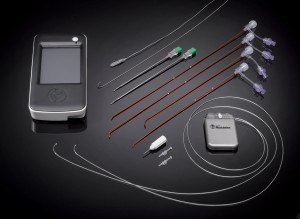 Our nervous system is the body’s electrical wiring system, making us move and perform a dance every day, from getting out of bed to chasing down a two year old with electrical impulses we never give a thought about.
Our nervous system is the body’s electrical wiring system, making us move and perform a dance every day, from getting out of bed to chasing down a two year old with electrical impulses we never give a thought about.
Yet a darker realm lives in many people where nerves pulsate signals gone awry leaving a peaceful body washed in neuropathic pain.
An epidemic that is more prevalent than heart, lung and cancer put together, chronic pain affects 115 million people in America, leaving them exhausted and desperate for relief. Pain is an odd animal and no two people experience it the same. It can be classified into two separate categories: nociceptive and neuropathic pain.
The former is your basic everyday hurt such as an ache from an injury or arthritis that irritates the nerve endings with dull or sharp pain from mild to severe.
But neuropathic pain involves the malfunction of the nervous system due to injury, illness or even from a surgery done perfectly. It can be sharp, intense, shocking, or bundles of shooting jolts.
Dr. Richard Paicius founder of Newport Headache and Pain (ocpain.com) specializes in interventional pain management and is recognized internationally for his work in spinal cord stimulation, a technique that benefits chronic pain patients.
Dr. Paicius completed his residency and internship at Harbor-UCLAMedicalCenter and is board certified by the American Board of Anesthesiology, the American Board of Pain Medicine, and earned extended qualifications by the ABA.
Having taught hundreds of physicians advanced techniques in interventional pain management, he is now very excited to be included in a pivotal clinical trial that has the potential to truly advance spinal cord stimulation to new levels and is named the ACCURATE study.
Using electricity to override pain has been in development since the 1970s, when nerves of the spinal nerve root were stimulated so burning pain “noise” could be reduced.
Now, the ACCURATE study for chronic lower limb pain is being conducted in 25 pain centers across the United States to evaluate the safety and efficacy of the Axium Neurostimulater System.
Data from the European studies show 89 percent of people with burning pain have 50 percent less pain with this devise.
How is it done? Dr. Paicius explains a trial run is initiated first to conclude if this will work for the patient.
Under an x-ray in a surgery center, a needle is used to apply a tiny wire smaller than a thin spaghetti noodle, leaving part of it hanging out so it can be pulled out easily once it is assessed that the device does indeed work in reducing the pain.
The placement is the key note in advancement from other stimulators because instead of targeting the spinal cord, this device is much more specific and can be placed in the nerve’s “fuse box” or DRG (dorsal root ganglion) located near the site of the pain that talks to the spinal cord.
The DRG plays a critical role in the development and maintenance of chronic pain as it processes pain signals traveling to the brain.
It’s well known that this fuse box acts differently with chronic nerve pain, so targeting this area with specific electricity overrides the pain before it has a chance to hitch a ride up the spinal cord.
The study has been gathering data since it started in August, 2013, and is still recruiting patients with chronic lower limb pain who would like to participate.
For more information on qualifying, go to accuratestudy.com or call (888) 978-8397.
Contact Gina at Ima_gina_tion@yahoo.com.




